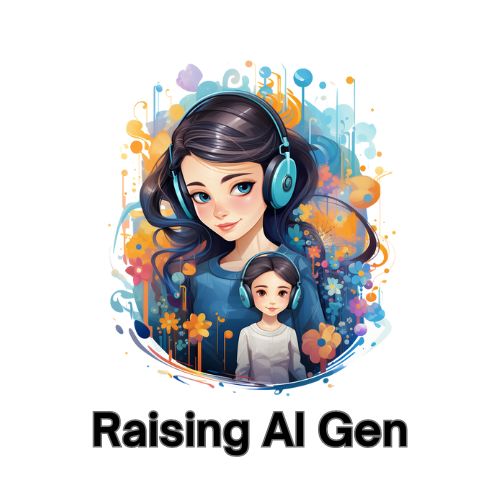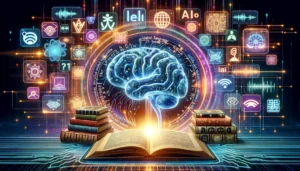In a world where Autism Spectrum Disorder (ASD) often walks hand in hand with misconceptions, the power of Artificial Intelligence (AI) heralds a new dawn.
The narrative of “AI for Autism” isn’t just a fleeting tech buzz, but a burgeoning realm of hope, poised to unravel the intricacies of Autism that have long baffled the scientific community.
Imagine a world where the enigmatic veil of Autism is gradually lifted, revealing a panorama of insights that could not only demystify the condition but significantly enhance the quality of life for individuals on the spectrum and their families.
The fusion of AI and Autism research is a beacon of hope, illuminating the path towards more effective, personalized interventions and a deeper understanding of this complex neurodevelopmental disorder.
The potential of AI in deciphering the myriad facets of Autism is as boundless as it is groundbreaking.
From early and precise diagnosis to tailor-made education and therapy programs, AI is steadily becoming a linchpin in Autism research and support.
This article embarks on an enlightening expedition into the heart of the synergy between AI and Autism, exploring groundbreaking initiatives, real-world impacts, and the promising horizon that lies ahead.
Key Takeaways
Key Points Description Early Diagnosis AI’s prowess in facilitating early diagnosis, thereby opening doors to timely interventions. Personalized Treatment The advent of AI engenders tailored therapies and support, catering to the individual needs of those on the Autism spectrum. Cross-Disciplinary Collaboration The essence of collaboration between AI experts, medical professionals, and educational institutions in advancing Autism research and support. Technological Advancements The continual strides in AI and machine learning models are broadening the realms of possibility in Autism research and support. Broader Implications A glimpse into how the AI for Autism narrative resonates with the broader scope of addressing developmental and neurological disorders.
Venture forth into a narrative that not only educates but inspires a progressive dialogue on AI for Autism, unveiling the transformative potential of AI in orchestrating a future where the Autism narrative is retold through a lens of hope, understanding, and actionable insight.
Early Diagnosis and Intervention: Northwestern’s Initiative
In the realm of Autism, time is of essence. Early diagnosis and intervention have been underscored as pivotal in enhancing the developmental trajectory of individuals on the Autism spectrum. “AI for Autism“, particularly in the context of early diagnosis, is a ray of hope shining through the clouds of uncertainty that often envelop Autism.
Novel Precision Medicine Approach
The initiative by Northwestern University is nothing short of revolutionary.
Embarking on a voyage into the uncharted waters of precision medicine enhanced by AI, the institution unveils a groundbreaking approach towards Autism diagnosis.
This initiative, a confluence of AI and biomedical data, is poised to redefine Autism diagnosis from a unique vantage point, shedding light on a subtype of Autism characterized by abnormal lipid levels, known as dyslipidemia-associated autism.
- Multilayered Data Analysis:
- Genetic mutation data
- Sexually different gene expression patterns
- Animal model data
- Electronic health record data
- Health insurance claims data
- AI-Enhanced Precision Medicine:
- Utilization of a state-of-the-art AI algorithm for clustering gene expression data, which functions like a magnifier to zoom into the intricate molecular signatures underlying Autism.
The approach mirrors the intricacy and the potential of today’s digital maps where various layers of information are overlaid to provide a true representation of the real world.
“This discovery was like finding a needle in a haystack, as there are thousands of variants in hundreds of genes thought to underlie Autism,” said Dr. Yuan Luo, shedding light on the monumental challenge and the potential payoff of this endeavor.
Implications for Early Screening and Intervention
The echo of this discovery reverberates beyond the halls of academia, heralding a new era of early and precise Autism diagnosis.
The ripple effect of this breakthrough is profound, with the potential to significantly impact early screening and subsequent intervention strategies.
- Earlier Autism Identification: The potential to identify Autism subtypes at an earlier stage, even before the manifestation of conspicuous symptoms, is a game-changer. This could potentially usher in a new era of proactive Autism care, a narrative that resonates well with our discussion on AI Personalized Learning.
- Targeted Intervention Strategies: With a more precise understanding of Autism subtypes, intervention strategies can be tailored to meet the specific needs of individuals, paving the way for more effective and personalized care.
- Parental Awareness and Preparation: Equipping parents with the knowledge of their child’s Autism subtype at an early stage can be empowering, enabling them to seek appropriate support and resources.
This section elucidates how the blend of AI and precision medicine by Northwestern University is a giant leap towards unravelling the mystery of Autism, offering a promise of early diagnosis and tailored interventions.
Deciphering Brain ‘Fingerprints’: Stanford’s Algorithm
The words “AI for Autism” stretches its tendrils into the intricate fabric of neural networks, hoping to decode the enigmatic brain ‘fingerprints’ of Autism. Stanford University, a vanguard in AI research, unfurls a promising algorithm that beholds the potential to transform the Autism narrative significantly.
The AI-Driven Algorithm
Stanford’s novel algorithm, bolstered by the burgeoning advances in AI, delves into the mysteries encapsulated in brain scans.
This quest is not merely about detection; it’s an endeavor to comprehend the severity of Autism symptoms in individuals, forging a path towards personalized care.
- Algorithm Highlights:
- Discerning Autism from brain scans.
- Predicting the severity of Autism symptoms.
- Spearheading a new dimension in Autism diagnosis and understanding.
“The algorithm is a window into the brain’s unique architecture in Autism, potentially leading to a more refined understanding and management of the condition,” elucidates a Stanford researcher.
Autism Glass Project
Stanford doesn’t stop at brain scans. The Autism Glass Project is a beacon of innovative thought, using machine learning and AI to create a real-time facial expression recognition system. This system, housed in wearable glasses, serves as a clinician in the pocket, aiding individuals with Autism in interpreting social cues.
- Project Highlights:
- Real-time facial expression recognition.
- Wearable technology aiding in social interaction.
- A step towards reducing social anxiety and enhancing communication for individuals with Autism.
The resonance of this project is profound, bridging the chasm between the Autism community and the world of social interaction.
This initiative dovetails seamlessly with our exploration on AI Speech Therapy and how AI can significantly enhance communication for individuals with Autism.
The Horizon Ahead
Stanford’s initiatives are emblematic of a broader movement towards leveraging AI to comprehend and manage Autism better.
They represent a marriage of technology and empathy, driving towards a future where the understanding of Autism is not a privilege but a right.
- Potential Future Developments:
- Expansion of AI-driven diagnostic tools.
- Integration of real-time assistance technologies in daily routines.
- Evolving therapeutic approaches driven by AI insights.
These ventures underscore the transformative potential of AI in reshaping the Autism narrative, paving the way towards a future where individuals with Autism are not just understood but empowered.
Speeding Up Autism Screening: USC’s Contribution
The journey toward unveiling the mysteries of Autism takes a brisk stride forward with the University of Southern California’s (USC) foray into the domain of AI-powered Autism screening. “AI for Autism” finds a staunch ally in USC, whose initiative is a testament to the boundless prospects that AI holds in accelerating Autism screening and, by extension, the pathway to timely interventions.
A New Dawn in Autism Screening
USC’s interdisciplinary team, armed with the prowess of AI, is on a mission to create a faster, more reliable, and accessible system for Autism screening.
This venture is not just about speed but accuracy, ensuring that the screening is a precise precursor to a journey of personalized care and support.
- Project Highlights:
- Development of a new machine-learning algorithm for Autism screening.
- Targeting early diagnosis to trigger timely interventions.
- Creating a system that stands as a sturdy bridge between detection and effective treatment.
“The crux of early Autism screening lies in the potential to significantly improve behavior, skills, and language development, making a monumental difference in the lives of affected children and their families,” states a researcher from USC.
Implications for Individuals and Families
The ripple effect of USC’s venture spans across individuals, families, and the broader community.
Early and accurate screening is a catalyst for timely interventions, which is crucial in enhancing the quality of life for individuals with Autism.
- Benefits Unveiled:
- Early Diagnosis: A door to a world of tailored interventions and therapies, resonating with our discourse on AI Personalized Learning.
- Empowered Families: Armed with precise knowledge, families can navigate the Autism journey with a clearer roadmap.
- Community Awareness: A step towards fostering a better understanding and acceptance of Autism in society.
Envisioning a Brighter Future
The narrative of AI for Autism is an ongoing saga of innovation, empathy, and hope.
USC’s initiative is a valuable chapter in this narrative, reflecting a future where AI is an integral companion in the Autism journey, from early screening to continuous support.
- Future Prospects:
- Further refinement and expansion of AI-based Autism screening tools.
- Integration of AI in developing effective intervention strategies.
- Fostering a global dialogue to leverage AI for Autism on a larger scale.
The essence of USC’s venture is a reflection of the broader ambition to harness AI’s potential in rewriting the Autism narrative, fostering a society that is not just aware but proactive in supporting individuals with Autism and their families.
Broader Implications and Future Directions
The narrative of AI for Autism is a compelling testament to the symbiotic relationship between technology and humanity.
The odyssey does not halt at Autism; it’s a prologue to a vast realm of possibilities where AI stands as a beacon of hope for myriad other developmental and neurological disorders.
Expanding Horizons of AI for Autism
The tapestry of AI in healthcare is rich and expansive, with each thread weaving into complex yet promising domains.
Autism, as a focal point, unveils the potential of AI in addressing multifaceted challenges inherent in other developmental disorders.
- AI in Developmental Disorders:
- Early diagnosis.
- Personalized intervention plans.
- Enhanced understanding and management.
The story of AI’s inroad into Autism care and understanding is a precursor to its potential role in addressing a spectrum of other developmental disorders.
The ethos of AI Personalized Learning resonates profoundly with this narrative, showcasing the transformative potential of AI in orchestrating tailored educational strategies for individuals with diverse learning needs.
Fostering a Global Dialogue
The convergence of AI and Autism care is a narrative that transcends geographical and cultural boundaries.
It beckons a global dialogue, a collective endeavor to harness the power of AI in rewriting the Autism narrative globally.
- Global Collaborative Initiatives:
- Cross-border research collaborations.
- Global forums for sharing insights and best practices.
- Engaging a broad spectrum of stakeholders including educators, healthcare professionals, and technology experts.
The Road Ahead
The journey of AI for Autism is akin to an enlightening expedition, each stride unveiling a new horizon of hope and potential.
The vistas are broad and promising, imbued with the potential to not only transform the lives of individuals with Autism but to herald a new era of understanding and acceptance.
- Future Projections:
- Advancements in AI-driven diagnostic tools.
- Exploration of AI in therapeutic interventions.
- Evolving societal awareness and acceptance facilitated by AI insights.
The narrative of AI for Autism is not a solitary chapter but a dynamic saga, embodying the spirit of innovation, empathy, and an unwavering commitment towards fostering a better understanding and support for individuals with Autism and other developmental disorders.
Frequently Asked Questions
The exploration of AI for Autism naturally invites a plethora of inquiries. In this section, we address some of the common questions to provide a clearer understanding of this transformative narrative.
| Questions | Answers |
| What is the significance of AI in Autism diagnosis? | AI facilitates a more precise and early diagnosis of Autism, enabling timely interventions and personalized care plans. |
| How does the AI algorithm by Stanford work? | The algorithm delves into brain scans to discern Autism and predict the severity of symptoms, paving the way for a better understanding and management of Autism. |
| What is the Autism Glass Project? | A venture by Stanford, the Autism Glass Project utilizes machine learning and wearable technology to provide real-time facial expression recognition, aiding individuals with Autism in interpreting social cues. |
| How does USC contribute to Autism screening? | USC has developed a machine-learning algorithm aimed at creating a faster, more reliable, and accessible system for Autism screening, promoting early diagnosis and intervention. |
| What are the broader implications of AI for Autism? | The fusion of AI and Autism care has the potential to enhance early diagnosis, personalized interventions, and foster a better understanding and acceptance of Autism both at a community and global level. |
| How can AI impact other developmental disorders? | The principles and technologies employed in AI for Autism can be extrapolated to address a range of developmental disorders, aiding in early diagnosis, personalized care, and enhanced understanding of these conditions. |
| What is the potential future of AI in Autism care? | The future holds promise for further advancements in AI-driven diagnostic tools, evolving therapeutic approaches, and fostering a global dialogue to leverage AI for Autism on a larger scale. |





